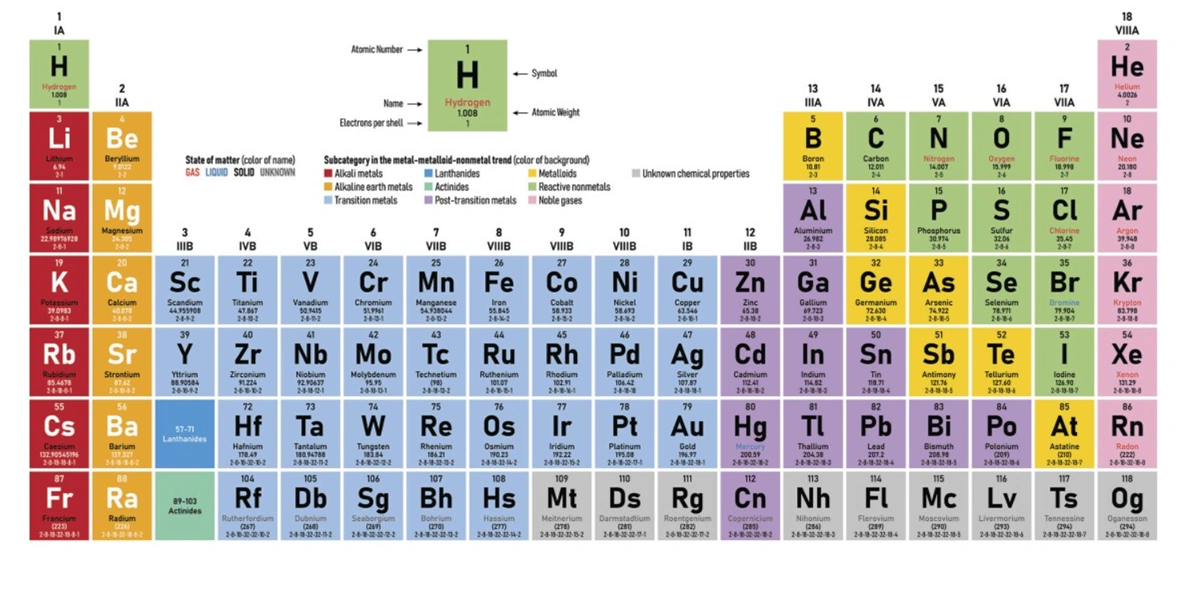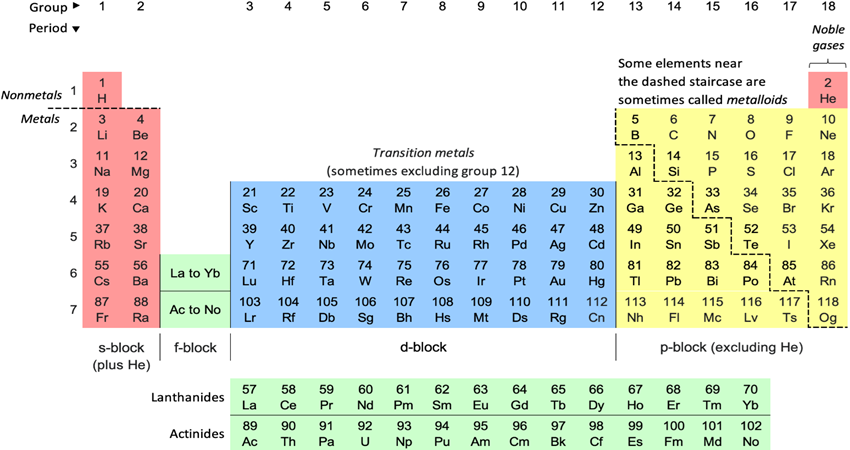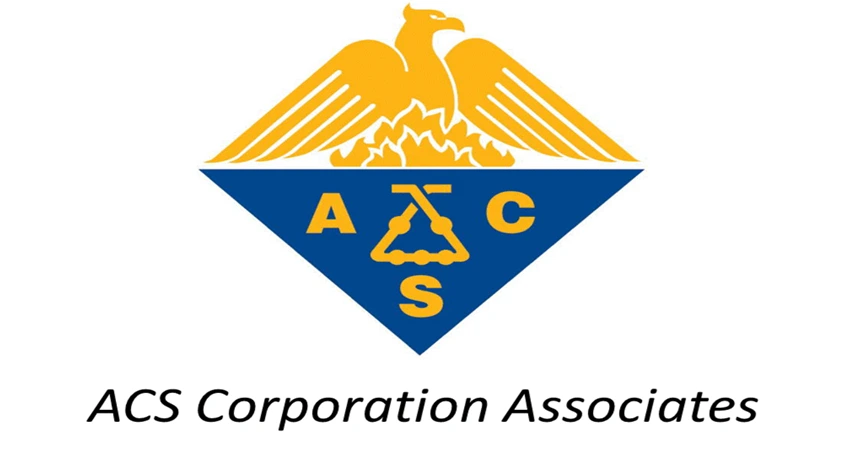Boiler feed water
A boiler is a device used to produce steam. One of the major uses of water in industry is generation of steam by boilers.
The water used to feed in boiler for the production of steam is called boiler feed water.
Requirement of boiler feed water
The specification of water required for boiler use is as follows.
| S. No | Water specification | Volume (ppm) |
| 1. | Hardness | <0.02 |
| 2. | Soda alkalinity | 0.15 – 1 |
| 3. | Caustic alkalinity | 0.15 – 0.45 |
| 4. | Excess soda ash | 0.3 – 0.55 |
The boiler feed water should be free from dissolved salts, gases, suspended impurities, silica and oil. When water from natural sources having hardness is fed directly to boilers, then the following problems or troubles may arise.
(i) Scale and sludge formation;
(ii) Priming and foaming;
(iii) Caustic embrittlement;
(iv) Boiler corrosion.
Scale and sludge formation in boilers
When water is converted into steam in boiler, the suspended and dissolved matters may get deposited within the boiler.
If these substances form hard or adherent deposits on the walls of the containers, they are called scales.
If these substances form soft or non-adherent coatings, then they are called sludge or mud.
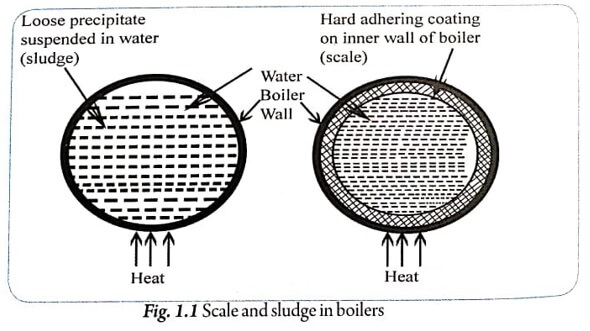
In boilers, water evaporates continuously and the concentration of the dissolved salts progressively increases. When the salt concentration reaches a saturation point, they are thrown out in the form of precipitates on the inner walls of the boiler. The less soluble one gets precipitated first.
Sludge
Nature of Sludge
- The principle sludge formers are MgCO3 , MgCl2 , CaCl2, MgSO4 etc.
- It is a soft, loose and slimy precipitate.
- It is formed at the cooler portions of the boiler.
- Sludge can be easily scrapped off with a wire brush.
Disadvantages of sludge formation
- Excessive sludge formation disturbs the normal functioning of the boiler.
- Sludge is a poor conductor of heat.
- Sludge does not allow the water to come in contact with plates and tubes of the boiler.
Prevention of sludge formation
- It can be prevented by using pure water.
- By ‘blow down operation’. That is, forced ejection of suspensions, dissolved solids and sludge from the boiler at regular intervals.
Scale
Nature of Scale
- The principle sludge formers are Ca(HCO3)2 , CaSO4 ,Mg(OH)2 etc.
- They are hard deposits which stick firmly to the inner surface of the boiler.
- Scales are the main source of boiler troubles, since it is difficult to remove.
Disadvantages of Scale formation
- Danger of boiler explosion.
- Wastage of heat energy and fuel.
- Decrease in boiler efficiency.
- It can be prevented by external and internal treatments.
- They can be removed by supplying thermal shock.
- They can be dissolved by using suitable chemicals such as EDTA and HCl.
Difference between sludge and scale
| S. No | Sludge | Scales |
| 1. | Sludges are soft and non-adherent deposits. | Scales are hard deposits which stick to the inner surface of boiler. |
| 2. | They can be removed easily. | They are very difficult to remove. |
| 3. | They can transfer heat to some extent and are less dangerous. | They are bad conductors of heat and are more dangerous. |
| 4. | They are formed by substances like MgCl2 and CaCl2. | Scales are formed by Substances like CaSO4, and Mg(OH)2 |
Priming and foaming in boilers
When a boiler produces steam rapidly, the steam containing small droplets of water is called ‘wet steam’. Such carrying over of water by steam along with the suspended and dissolved solids is called ‘carry over’. This is mainly due to priming and foaming.
| Priming | Foaming |
| The process of production of wet steam formation is called priming. | Foaming is the formation of small but permanent bubbles above the surface of the water, which do not break easily. |
|
Priming is caused due to:
|
Foaming is caused due to
|
|
Priming can be avoided by:
|
Foaming can be eliminated by:
|
Disadvantages of priming and forming
(i) The life of machinery is decreased.
(ii) Maintenance of pressure in the boiler becomes difficult as the exact height of the water level cannot be judged properly.
(iii) Priming and forming occur together. They are harmful because efficiency of the super heater and the turbine blades decreases as the dissolved salts carried by the wet steam get deposited on them.
Caustic embrittlement
This is a type of corrosion which may attack boilers. This type of corrosion is caused by high alkalinity (concentrate NaOH) of the boiler feed water. This type of corrosion is observed in high-pressure boilers.
Causes
Presence of sodium carbonate (Na2CO3) is responsible for caustic embrittlement. In high-pressure boilers, Na2CO3is hydrolysed to produce sodium hydroxide, and this makes the boiler water “caustic”.
Na2CO3 + H2O → 2NAOH + CO2
Sodium carbonate + water Sodium hydroxide + Carbon dioxide
Sodium hydroxide (NaOH), thus formed flows into the minute, irregular, intergranular hair-line cracks which are present in the inner sides of the boiler and induces caustic embrittlement.
Water evaporates slowly and the concentration of caustic NaOH increases. This NaOH attacks the surrounding area and dissolves iron of boiler as sodium ferroate, where the metal is stressed. This causes embrittlement of boiler parts such as joints, rivets, bends etc., causing even failure of the boilers.
Prevention
(i) sodium phosphate can be used instead of sodium carbonate;
(ii) by adding tannin or lignin to the boiler water;
(iv) by adjusting the pH of the solution between 8 and 9;
(iii) by adding sodium sulphate (Na2SO4) to the boiler water, preventing the infiltration of sodium hydroxide (NaOH) into the cracks.
Boiler corrosion
Boiler corrosion is due to the decay of boiler material by a chemical or electrochemical attack from its environment. It is caused by using the unsuitable water in the boilers.
(i) dissolved oxygen;
(ii) dissolved carbon dioxide;
(iii) dissolved salts.
(i) Boiler corrosion due to dissolved oxygen
Water contains about 8ml of dissolved oxygen per litre at the room temperature. At high temperatures, this dissolved oxygen attacks the boiler material.
Ferrous hydroxide Rust
Removal of O2
In order to avoid boiler corrosion, the dissolved oxygen in the water should be removed. This can be carried out by chemical or mechanical methods.
Sodium sulphite converts the dissolved oxygen into sodium sulphate.
Hydrazine converts the dissolved oxygen into water (H2O).
N2H4 + O2 → N2 + 2H2O
Hydrazine Nitrogen Water
(b) Mechanical method:
By mechanical deaeration method dissolved O2 can be removed from water.
Deaerator is a tower filled with perforated plates. Water is allowed to fall through the plates from the top and deaerator is heated from outside, which is connected to a vaccum pump (to reduce pressure inside the chamber). Availability of high temperature, low pressure and large exposed surface reduces the dissolved oxygen content in water.
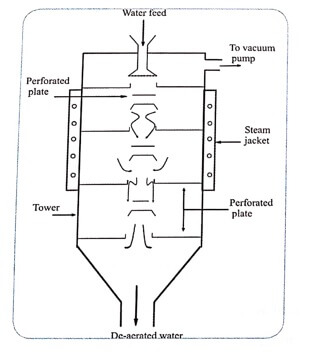
Fig 1.2 Mechanical deaerator
(ii) Boiler corrosion due to dissolved carbon dioxide (CO2)
Presence of carbon dioxide in the boiler water also induces boiler corrosion.
Carbon dioxide in the water gets converted into carbonic acid [H2CO3]. Carbonic acid (H2CO3) thus formed has a slow corrosive effect on the boiler material.
CO2 + H2O → H2CO3
Carbon dioxide + Water Carbonic acid
Removal of CO2
Carbonic oxide present in the boiler water can be removed by treating it with aqueous ammonia [NH4OH].
2NH4OH + CO2 → (NH4)2CO3 + H2O
-
- It can be removed by filtration through limestone.
- It can be removed by mechanical deaeration process.
(iii) Boiler corrosion due to dissolved salt
Dissolved salts like magnesium chloride (MgCl2) undergo hydrolysis and liberate acids. The liberated acid reacts with iron which attacks boiler in a chain like reactions producing HCl again and again that leads to corrosion.
MgCl2 + 2H2O → Mg(OH)2 +2HCl
Fe + 2HCl → FeCl2 +H2 ↑
FeCl2 + 2H2O → Fe(OH)2 ↑ + 2HCl
Removal of acids
Corrosion by acids can be neutralised with suitable alkaline solution in the boiler water.
| Read More Topics |
| Introduction of water technology |
| Dalton’s law of partial pressures |
| Chemical vapour deposition (CVD) |
